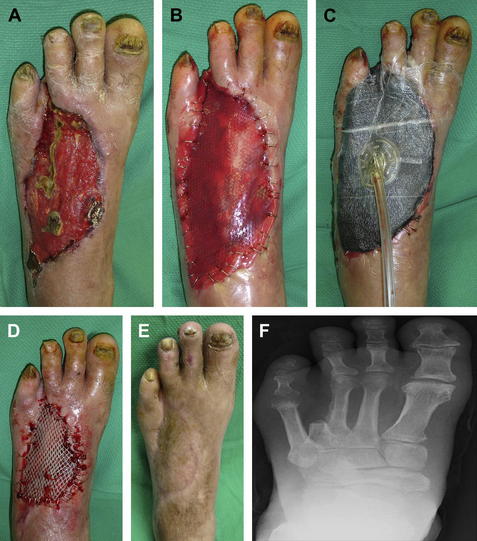Current Concepts and Techniques in Foot and Ankle Surgery
Surgical Soft Tissue Closure of Severe Diabetic Foot Infections: A Combination of Biologics, Negative Pressure Wound Therapy, and Skin Grafting
Keywords
• Diabetic foot • Wounds • Neuropathy • Biologics • Negative pressure wound therapy • Amputation
Foot infections and associated wounds are the leading cause of hospitalization of diabetics.1 Expedited closure of diabetic foot wounds can reduce the risk for major limb amputation and decrease costs associated with prolonged wound care.2 Well-established surgical techniques such as primary closure, flaps, and skin grafting are not always suitable for early closure of extensive diabetic foot and ankle wounds. Recent advances in wound care modalities, including tissue-engineered products such as bilayer matrix scaffolds, can accelerate healing in these patients.3 The Integra Bilayer Matrix Wound Dressing (Integra Life Sciences, Plainsboro, NJ, USA) is a collagen-based synthetic graft that facilitates cellular invasion and capillary growth into the wound, and its outer layer is made from silicone. The adjunctive use of negative pressure wound therapy (NPWT) can augment the healing process and prepare for definitive closure through skin grafting. This article presents a stepwise approach detailing the combination of these surgical techniques for the closure of complicated diabetic foot wounds.
Case report
Eight weeks later, and after local wound care with moist to dry dressings, the patient returned to the operating room for definitive wound closure through split thickness skin grafting (STSG). The recipient wound bed was first prepared through hydrosurgical debridement. The donor site at the lower lateral aspect of the ipsilateral leg was used for the skin harvesting. An electric dermatome was used to carefully harvest the appropriately sized skin graft, which was meshed in a 1:1.5 ratio. The harvested STSG was anchored to the recipient bed by staples followed by application of a bolster dressing and a well-padded lower extremity posterior splint. After 3 weeks of non–weight bearing to the operative foot, the dressing and staples were removed revealing great healing signs at both the recipient and donor sites. The patient was then transitioned to full weight-bearing status in a postoperative shoe and eventually progressed into extra depth shoes. At the patient’s latest clinical visit at 18 weeks, he had no recurrence of wound or infection and no difficulty with ambulation (Fig. 1).
Stay updated, free articles. Join our Telegram channel

Full access? Get Clinical Tree









